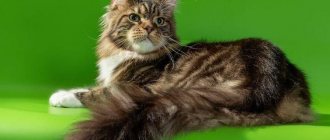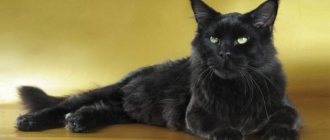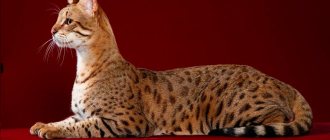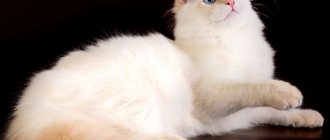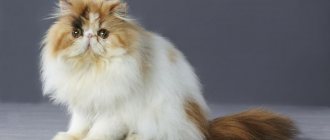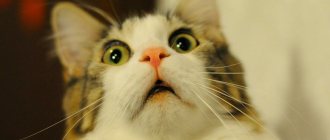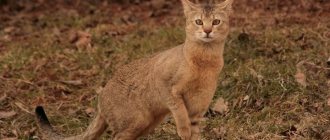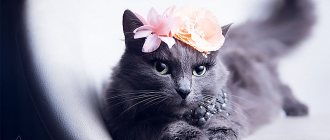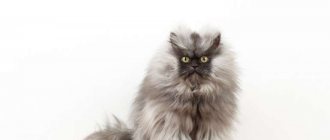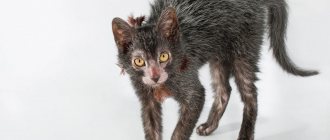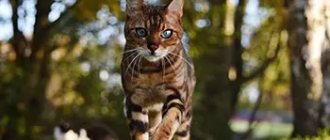Maine Coon
If you can't decide whether to get a cat or a dog, then get a Maine Coon. Cats of this breed can and even should be walked outside on a leash. Maine Coons are large and charming animals, with fluffy fur and funny tufts on their ears. By nature they are phlegmatic and kind.
Photo: richcoon.ru
Toyger
Toygers are the so-called indoor tigers. However, the only thing they have in common with large predators is their beautiful color. Representatives of this breed are absolutely not aggressive. On the contrary, they are very good-natured, friendly and flexible. A toyger will never scratch or bite without reason. Such a pet will happily sit in the owner’s arms and purr.
German Rex
Cats with short, curly, soft fur that is very pleasant to the touch. The German Rex is an affectionate and gentle friend. He will not peel off wallpaper or jump on cabinets because he has a calm character. Cats of this breed have been extremely popular in the world for several decades.
Photo: klkfavorit.ru
Snow-shoe
This breed was created by crossing a Siamese cat with an American Shorthair. Snow-shu is translated from English as “snow slipper.” The breed was named so because all its representatives have white socks on their paws. There are only two types of snowshoe coat colors: blue point and seal point.
These four-legged friends are very kind, affectionate and obedient. They get along great with children. Snowshoes do not need special care. In addition, these cats are not afraid of water. Therefore, they take bathing absolutely calmly.
Scottish fold
The Scottish Fold or Scottish Fold cat is a very smart, calm and balanced animal, does not require serious care, is affectionate and loving. Their calling card is their thick, plush fur and large eyes with an amber tint.
Photo: ru.wallpaper.mob.org
Small dog breeds: names and photos (catalog)
Ragdoll
Translated from English, the name of the breed means “rag doll.” Ragdoll cats have a gentle character; if you sit them on your lap and stroke them, they immediately relax and lie down. Such a pet will bring you a lot of pleasure and enjoyment from communicating with it. Plus, these cats are very adorable and cute!
Photo: krasivosti.pro
Siberian cat
This cat breed has an independent, regal character, but at the same time loves affection and becomes attached to its owner. Luxurious wool, varied colors, and harmonious physique are valued by cat lovers all over the world. Siberian cats are very smart, playful and unpretentious, they easily learn to use a tray and are excellent at catching mice.
Photo: krasivosti.pro
Nibelung
Nibelung kittens are extremely cute and cute. It is extremely difficult to resist buying such a fluffy miracle, because this breed was created to bring joy and positive emotions.
The kitten shows attention to everything that happens around. He can run for hours after a sunbeam or a piece of foil. Light-hearted in character, the Nibelung quickly charges those around him with positivity.
Bengal cat
Another “cat-dog” in the cat world. A large, long-legged, muscular cat with a strong build. Bengal cats have a very beautiful golden or silver color with spots, like wild animals. Seals of this breed are often called “snow leopards.”
Photo: krasivosti.pro
The smartest dog breeds: names and photos (catalog)
Genetics is the basis of everything
The ancestors of modern “mustachios” inhabited the hot savannas of Africa and the forests of Europe. At that time, cats used color solely for the purpose of survival and hunting. Inconspicuousness on the sand, among bushes and tree branches was achieved thanks to gray and brown tones, as well as numerous stripes and spots scattered over the entire surface of the fur coat. As a result of domestication and subsequent selection, cat colors have become more diverse and unusual.
The color of the hairs is determined by a special pigment - melanin, which is divided into 2 types:
- pheomelanin, which gives pigmentation in the red-yellow-orange spectrum by reflecting the rays of the sun;
- eumelanin, which gives black pigmentation by absorbing the rays of the sun.
Experienced cat owners will confirm that the coat of male cats has a less rich color palette. This is also explained by genetics.
Pheomelanin and eumelanin activate 2 genes: O and o, respectively. They are present only on X chromosomes, that is, the coat color is firmly linked to the sex. In the genetic code of females there are as many as 2 X chromosomes, so they have 3 basic colors available to them:
- red, or red (OO);
- black(oo);
- tortoiseshell (Oo).
Males have only one X chromosome. The latter option is not typical for them, but still sometimes occurs and is accompanied by infertility.
The genes listed are only part of a huge system. In addition to them, there are also those that are responsible for the saturation, brightness and contrast of the final color. Based on these characteristics, all existing cat colors are divided into the following types:
- solid, or solid;
- colors with white, including piebald;
- tabby, or tabby;
- tipping, or typed;
- color point, or acromelanism.
The coloring of the kittens' coat depends on the correct crossing of their parents. For this reason, breeders of purebred animals strictly monitor the pedigree and be sure to check the documents of partners for the upcoming mating.
American Curl
Cats of this breed have a unique ear shape. The auricle is bent back. They are also valued for their dense, but soft and silky fur. Take an American Curl in your arms one day and you will understand that this is love for life. This is what the happy owners of these graceful and kind pets say.
Photo: top10rating.com
What diseases are they susceptible to?
In addition to classic cat diseases (formation of stones in the ureter, hairballs getting stuck in the intestines, etc.), representatives of breeding families have a predisposition to characteristic diseases of the breed.
| Breed | Nuances of health |
| Neva Masquerade | Quite healthy cats. The exception is hereditary hypertrophic cardiomyopathy and the problem of fur getting stuck in the gastrointestinal tract, which is common to all long-haired breeds. |
| British and Scottish Shorthairs | Animals with very good health. The only thing you need to pay attention to is the two blood types of British people, which affect the quality of the offspring. Fold-eared individuals may have problems with the musculoskeletal system caused by the gene that lowers the ears. |
| Balinese | Apsaras inherited from the Siamese amyloidosis (protein metabolism disorder), cardiomyopathy, hip dysplasia, and diabetes. Strabismus is common and is not considered a disease. |
| Abyssins | They are quite healthy, but due to improper diet the kidneys often suffer (failure, amyloidosis), and individuals with blue fur often develop polycystic disease. In rare cases, joint dysplasia, retinopathy or a lack of red blood cells may occur. |
| Turkish Angora | Overall a hardy breed. However, due to albinism, partial or complete deafness is possible (in cats with heterochromia, the deaf ear is always on the side of the blue eye), muscle ataxia and heart problems. |
| Somalia | Animals with good immunity. Autoimmune hemolytic anemia (AIHA) is rare. They need daily brushing of their teeth or a special enamel-cleansing food. |
| American Curl | The gene responsible for the shape of the ears sometimes provokes diseases of the musculoskeletal system. Otherwise, curly-eared cats are in good health. |
| Russian blue | The filigree work of breeders provided the Russians with excellent immunity without a predisposition to any diseases. |
| Maine Coons | The heart or joints often hurt, obesity, physical inactivity, and urolithiasis are observed. The body develops slowly, but wears out quickly. |
| Classic Persians, extreme sports, exotics | A flattened muzzle that disrupts the normal arrangement of organs leads to increased tearing and the formation of tartar, breathing problems, and the occurrence of gingivitis. Half of the extreme/exotic livestock suffers from polycystic kidney disease and renal failure. There is also a genetic predisposition to hypertrophic cardiomyopathy, retinal atrophy, and hip dysplasia. |
Kenyan forest cat
The Kenyan cat is also called "sokoke" or "soukok". They have long legs, a slender, toned body, large tufted ears and a flexible tail with a black tip. Don't look into her eyes, she will hypnotize you! The fact is that depending on the mood, the color of the eyes of the Kenyan forest cat changes from green to rich amber. Amazing sight!
Photo: petchel.ru
Content Features
Luxurious cats deserve a luxurious life. Before bringing an animal into your home, read about the correct conditions for keeping the breed. In particular:
- Rules of care and hygiene Many amazing purrs require a special approach to grooming. Those with long hair will have to be combed regularly, brachycephalics will have to clean creases on their faces, lop-eared cats will have to be helped to get rid of wax in their ears, and hairless cats will have to clean their folds daily, moisturize and cover their skin with sunscreen.
- Pet menu The basis of the diet of expensive (and any other) cats should be balanced natural food. Adding premium food is possible at the discretion of a veterinarian who knows the characteristics of the breed.
- Peculiarities of education Some types of cats need experienced owners or trainers. For example, Balinese, Abyssinians and other hyperactive, wayward companions are not recommended for those who have not previously had successful experience in training mustachioed and striped pets.
Come, I’ll educate you!
Tennessee Rex
The Tennessee Rex can be recognized by its ears, which are rounded at the ends. These are imposing, large and graceful cats. Their fur is curly throughout the body, but it does not mat and is not prone to falling out.
Photo: petshoptop.com
The most obedient dog breeds: names and photos
Persian
Little peaches bring aesthetic pleasure to the family with their upturned nose, chic fur coat and intelligent eyes. They are very loving, have an easy-going character, restrained and noble.
Loyalty to the owner is a distinctive feature of the Persians. They follow him around the house, rarely leaving him alone. The Persian breed needs to give their love, so they sleep with their owner and stay close while he takes a shower. They are happy just to be around.
ring-tailed cat
Ring-tailed cat or American ringtail - this breed is not yet officially recognized in the world. But this does not affect her popularity in any way. Still, a tail curled into a ring is an amazing feature in the cat world. Moreover, the tail is very flexible, sometimes it can curl into a spiral. The American Ringtail is also capable of simply placing its tail on its back and walking. Definitely one of the most unique and beautiful breeds!
Photo: koteiki.com
Munchkin
Munchkin - the “dachshund” in the cat world
The breed in question is one of the most discussed in the cat kingdom, and its main distinguishing feature is its very short legs. Munchkins like to sit on their hind legs, like gophers, and often grasp objects with their front legs. They are jokingly called dachshund cats or simply shorties. They conquered the world so quickly that the term “munchkinomania” even appeared on the Russian-speaking Internet.
It is known that short-legged cats were bred in the 30s in England. Then 4 generations of shorties were born. But the Second World War made its own adjustments and the breed could not be preserved. The modern history of munchkins began in the early 80s, when American Sandra Hochenedel from Louisiana picked up a black and white pregnant cat with short legs on the street and named her Blackberry. Of several kittens, one inherited its mother's feature. They named him Tuluus. Blackberry and her own son became the bosses of all modern munchkins.
The breed owes its name to the short magical people described in the book “The Wizard of Oz.” Munchkins have given rise to several new experimental breeds.
The Munchkin's body is slightly elongated, its legs are 2-3 times shorter than those of an ordinary cat. They are playful, cheerful and loving creatures by nature, who are not upset if they cannot jump on a high table, but find other exciting fun on the floor. Prices fluctuate within a very wide range.
Caracal
In ancient times, caracals were faithful companions of noble hunters; they were excellent at catching birds and hares. Today, cats of this breed have been tamed so much that they feel great in spacious houses and apartments. Outwardly, the caracal resembles a small lynx; they are very dexterous and graceful animals, but docile and affectionate in nature. Caracals cannot purr - the sounds they make are more like the chirping of birds.
Photo: klkfavorit.ru
Did you like the post? Subscribe to our channel in Yandex.Zen, it really helps us in our development!
